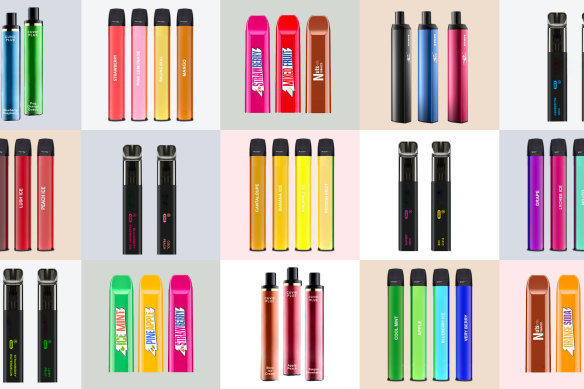In 2021 it became illegal in Australia to use or supply nicotine-containing vaping devices without a prescription. Yet they have continued to flourish thanks to ineffective import controls, energetic offshore manufacturers, confusion over products that claim to be nicotine-free and a widespread black market online and under the counter.
The Therapeutic Goods Administration observed last year in a consultation paper that the 2021 reforms had failed to prevent children and adolescents from obtaining nicotine-containing vaping devices “in higher numbers”, that there was “evidence that many adults are accessing [these devices] without a prescription, rather than through lawful supply channels” and that it appeared “large volumes of [devices] are being imported, and supplied, unlawfully”.
Vape flavours would be banned under a crackdown being recommended by the Therapeutic Goods Administration to stamp out vaping among young people.Credit:Mark Stehle
Vapes have been used as a tool to help smokers quit cigarettes, hence their continuing legitimacy on prescription in Australia.
But that in no way means they are necessarily safe; on the contrary, for people who have never smoked, vaping can be both a gateway into cigarettes proper and an unquantified health hazard in its own right. There are only a limited number of doctors willing to prescribe vapes as a smoking-cessation tool.
Little is yet known about the long-term health effects of inhaling heated vape fluid, but researchers warn that some of the chemicals it typically contains are likely to be harmful, especially when combined.
The fluid in unregulated products can comprise a cocktail of preservatives, synthetic coolants, heavy metals, microparticles and random contaminants.
A 2018 US survey found “various chemical substances and ultrafine particles known to be toxic, carcinogenic, and/or to cause respiratory and cardiac disease have been identified in e-cigarette aerosols, cartridges, refill liquids, and environmental emissions”.
It also observed that little was known about the flavourings that add to the appeal of vaping products, particularly to children and adolescents, except that even those considered safe to eat could pose a health risk when inhaled.
A study from 2021 found nearly a third of teenagers aged 14 to 17 surveyed in NSW had used vaping products and more than half of that group had knowingly used a vape that contained nicotine. Research from the Australian National University, meanwhile, suggests that vaping encourages young people to subsequently take up cigarette smoking.
Some vapes are free of nicotine, but the TGA has found that manufacturers are now deliberately concealing the nicotine content to evade the new regulations.
There is an argument that vapes should be broadly legalised and regulated like cigarettes or alcohol. Until we know much more about their long-term health effects, however, a more cautious approach remains appropriate.
The TGA, after considering nearly 4000 submissions in a consultation process started last year, has recommended new supervisory measures, including tighter import controls, product design standards and restrictions on appearance and flavourings.
Clearly, these measures, if adopted, must be accompanied by better enforcement if they are to prove effective, particularly in the campaign to keep vapes away from children and adolescents, whose developing respiratory systems are especially vulnerable. After all our efforts to wind back tobacco smoking, we must not allow another insidious health disaster in the making to take an ever greater hold.
Patrick Elligett sends an exclusive newsletter to subscribers each week. Sign up to receive his Note from the Editor.
Most Viewed in National
From our partners
Source: Read Full Article



